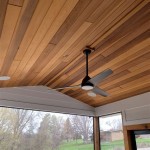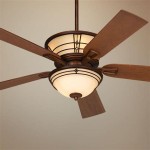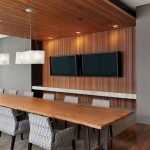Best Ceiling Fans For Small Rooms
Selecting the appropriate ceiling fan for a small room can significantly impact comfort, energy efficiency, and aesthetics. Given the limited space, factors such as fan size, blade pitch, motor type, and lighting options must be carefully considered. This article explores key considerations and presents a selection of ceiling fans well-suited for smaller rooms.
Understanding the Importance of Size and Blade Span
The primary consideration when choosing a ceiling fan for a small room is size. A fan that is too large will overwhelm the space, creating a visually cluttered look and potentially causing excessive airflow that leads to discomfort. Conversely, a fan that is too small will not effectively circulate air, rendering it ineffective. The blade span, which is the diameter of the circle the blades create when spinning, is the most crucial size metric.
For rooms up to 75 square feet, a ceiling fan with a blade span of 36 inches or less is generally recommended. Rooms between 75 and 100 square feet can typically accommodate a 42-inch fan. Anything larger will likely be more appropriate for a larger area. Proper sizing ensures efficient airflow and prevents the fan from being a dominant feature in the room.
Beyond the overall blade span, the number of blades can also subtly impact airflow and aesthetics. While the number of blades doesn't directly correlate to efficiency, a fan with more blades (five or six) might offer a more distributed and gentle breeze, which can be desirable in a smaller space. Conversely, a fan with fewer blades (three or four) might move air more forcefully, although this can also be a function of the motor and blade pitch.
Flush-mount or hugger-style ceiling fans are often the best choice for rooms with low ceilings. These fans are designed to sit close to the ceiling, maximizing headroom and preventing the fan from feeling intrusive. For rooms with standard or higher ceilings, a downrod can be used to hang the fan at the optimal height for airflow. The ideal distance between the fan blades and the floor is typically around 7 to 9 feet. This accounts to prevent the fan from being too low, where it can pose a safety hazard or disrupt the room's visual balance. In small spaces, every inch matters, so accurately measuring the ceiling height is vital before installation.
Key Features to Consider: Motor Type, Blade Pitch, and Lighting
Besides size, several other features contribute to a ceiling fan's effectiveness and suitability for a small room. These include the motor type, blade pitch, and lighting options. The motor type directly influences the fan's energy efficiency and noise level, while the blade pitch affects airflow. Lighting options provide additional functionality and can enhance the room's ambiance.
Ceiling fans typically come with AC or DC motors. AC motors are the more traditional and generally less expensive option. However, DC motors are significantly more energy-efficient, quieter, and offer a wider range of speed settings. While the initial investment might be higher for a DC motor fan, the long-term energy savings and improved performance can make it a worthwhile upgrade, especially for fans used frequently. A quiet motor is particularly important in bedrooms or other spaces where noise could be disruptive.
Blade pitch refers to the angle at which the fan blades are set. A steeper blade pitch typically results in greater airflow, but it can also increase noise levels. For small rooms, a moderate blade pitch is often ideal, providing sufficient airflow without creating excessive noise. It is important to check the fan's airflow rating (measured in cubic feet per minute, or CFM) to ensure it is suitable for the room's size. A higher CFM indicates greater airflow capacity.
Lighting is another important consideration. Many ceiling fans for small rooms come with integrated light fixtures, which can serve as the primary source of illumination. LED lights are a popular choice due to their energy efficiency, long lifespan, and ability to produce a bright, even light. Some fans also offer dimming capabilities, allowing one to adjust the brightness to create the desired mood. When selecting a ceiling fan with a light, consider the color temperature of the light bulb. Warmer light (around 2700-3000K) creates a cozy and inviting atmosphere, while cooler light (around 4000-5000K) is more suitable for tasks and activities. Consider the existing lighting in the room and select a fan with lighting that complements it.
Style, Design, and Remote Control Functionality
Beyond the functional aspects, the style and design of the ceiling fan should also be considered. A ceiling fan should complement the room's existing décor and contribute to its overall aesthetic appeal. The availability of remote control functionality is also a significant convenience.
Ceiling fans come in a wide range of styles, from traditional to contemporary. For small rooms, simplicity is often the best approach. A fan with clean lines and a minimalist design can blend seamlessly into the space without overwhelming it. Consider the color of the fan's housing and blades. Neutral colors like white, black, or brushed nickel are versatile and can easily coordinate with most décor schemes. Wood-tone blades can add warmth and character to a room, but it's important to ensure they complement the existing wood finishes.
The design of the fan can also influence the perceived size of the room. A fan with a low profile and a light color can help to visually expand the space, while a dark or ornate fan can make the room feel smaller. Consider the room's architectural style and select a fan that complements it. For example, a modern room might benefit from a fan with sleek lines and metal accents, while a more traditional room might be better suited to a fan with decorative details and a classic finish.
Remote control functionality can be a valuable addition, especially for fans that are difficult to reach. A remote control allows you to easily adjust the fan's speed and lighting from anywhere in the room. Some remotes also offer additional features such as timers and reverse function, which can be useful for circulating warm air in the winter. A fan with remote control capability is more convenient and can make it easier to maintain a comfortable temperature in the room. It is important to select a remote with intuitive controls and a clear display.
Installation is another important factor to consider. While many ceiling fans can be installed by homeowners with basic electrical knowledge, it is always recommended to hire a qualified electrician to ensure the installation is done safely and correctly. This is particularly important if the room does not already have a ceiling fan wiring. A professional installation will ensure that the fan is properly grounded and securely mounted, preventing any potential safety hazards. Check if the fan comes with clear and detailed installation instructions. If not, consider seeking professional assistance.
Ultimately, the best ceiling fan for a small room is one that effectively circulates air, provides adequate lighting, complements the room's décor, and offers convenient functionality. Size, motor type, blade pitch, lighting options, style, and remote control functionality are all important factors to consider when making your selection. By carefully evaluating these factors, you can choose a ceiling fan that enhances the comfort and aesthetics of your small room.

Small Room Ceiling Fans Best For Rooms Hunter Fan

Small Room Ceiling Fans Best For Rooms Hunter Fan

Best Small Room Fans For Bedrooms Bathrooms Kitchens More Delmarfans Com

Best Ceiling Fans For Small Rooms Lumera Living

How To For A Ceiling Fan Reviews By Wirecutter

Best Ceiling Fans 2024 The Strategist

Best Ceiling Fans 13 Options For Any Style Or Budget Time Stamped

Bell Howell 15 7 In Indoor White Ceiling Fan With Remote Led Light Socket 8563encbqh The Home Depot

16 Best Ceiling Fans For Extra Airflow In 2024

What Size Ceiling Fan Do You Need For Your Room Dan S City Fans Parts Accessories
Related Posts








